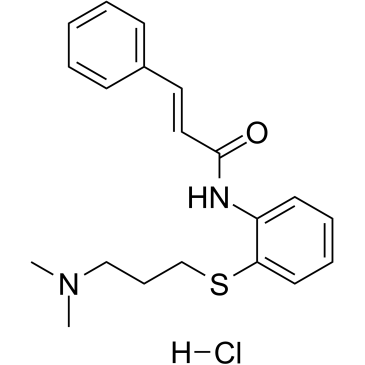54-84-2
| Name | cinanserin hydrochloride |
|---|---|
| Synonyms |
maptc
Cinnanserin sq10,643 CINANSERIN DPTC HYDROCHLORIDE DPTC |
| Description | Cinanserin hydrochloride (SQ 10643) is a potent, selective and highly affinity 5-HT2 receptor antagonist with a Ki of 41 nM. Cinanserin hydrochloride has a much higher binding affinity for the 5-HT2 than for the 5-HT1 receptor (Ki of 3500 nM). Cinanserin is also an inhibitor of 3C-like proteinase of severe acute respiratory syndrome coronavirus and strongly reduces virus replication in vitro[1][2][3]. |
|---|---|
| Related Catalog | |
| Target |
Ki: 41 nM (5-HT2 receptor)[3]; 3C-like proteinase[1] |
| In Vitro | Cinanserin/Cinanserin hydrochloride have binding affinity to SARS-CoV 3CLpro, HCoV-229E 3CLpro, with the KD values of 49.4 μM/78.0 μM for SARS-associated coronavirus (SARS-CoV) 3CLpro and 18.2 μM/36.6 μM for human coronavirus 229E (HCoV-229E) 3CLpro[1]. The IC50 values of Cinanserin and Cinanserin hydrochloride for inhibiting the catalytic activity of SARS-CoV 3CLpro are calculated as 4.92 μM and 5.05 μM, respectively, The corresponding IC50 values for HCoV-229E 3CLpro are 4.68 μM and 5.68 μM. None of the compounds have inhibitory activity against HRV-14 3Cpro at concentrations up to 200 μM[1]. |
| In Vivo | Cinanserin (5 mg/kg; intravenous injection; for 2 hours; male Wistar rats) treatment significantly reduces systemic burn edema to shamburn levels. Leukocyte-endothelial interactions are significantly reduced by administration of Cinanserin[2]. Animal Model: Male Wistar rats (250 g) underwent thermal injury[2] Dosage: 5 mg/kg Administration: Intravenous injection; for 2 hours Result: Significantly reduced systemic burn edema to shamburn levels.. |
| References |
| Boiling Point | 519.5ºC at 760mmHg |
|---|---|
| Molecular Formula | C20H25ClN2OS |
| Molecular Weight | 376.94300 |
| Flash Point | 268ºC |
| Exact Mass | 376.13800 |
| PSA | 57.64000 |
| LogP | 5.25730 |
CHEMICAL IDENTIFICATION
HEALTH HAZARD DATAACUTE TOXICITY DATA
|
